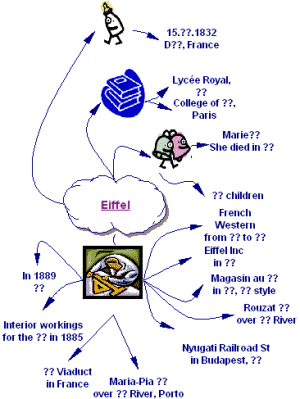Gustave Eiffel |
|
Eiffel's was famous for his new work with wrought iron bridges and structures. He was known for "bridge kits" that could be assembled nearly anywhere. His bridges were extraordinarily strong but light and were famous for having good wind resistance because of the cross design and lattice of the iron. His buildings were known to be full of light on the interior and exhibited his style of strong, but delicate architecture as well. In 1856, he got a job at Nepveu & Cie., an architectural firm in Paris and when he was 25 he supervised the building of the Garonne Bridge in Bordeaux. This was his first big project . From 1857 to 1864 he worked as an engineer for the French Western Railway Company, building innovative bridges of strong, but lightweight wrought-iron. In 1866 he founded his own engineering company, Eiffel Inc., and designed many bridges for countries such as France, Spain, Austria, Egypt and Peru. In 1869 he completed the Rouzat Viaduct which crosses the Sioule River in France. In 1876 he completed the Magasin au Bon Marche, also in Paris, which is a Victorian style department store made of iron and masonry. In 1879 he designed the Nyugati Railroad Station in Budapest, Hungary Other famous architectural achievements include the Maria-Pia Bridge in Portugal over the Douro River in Porto, which was completed in 1879. In 1880 he built a bridge over the Danube River in Hungary and began work on the Garabit Viaduct in France. The viaduct crosses the Truyere River and was not completed until 1884. The Garabit Viaduct was considered to be one of his most beautiful and masterful works and is still regarded as such today. In 1884, Gustave Eiffel first began studying towers and in 1885 he designed the interior workings for the Statue of Liberty, which of course was to be a gift symbolizing international friendship from France to the United States. In 1887, Paris began planning for the World's Fair and looking at proposals for a new building that would commemorate the 100th anniversary of French Revolution and impress visitors to France. Eiffel's tower won the design competition. His new tower would be the tallest in the world at 300m and was impressive because of its innovative design, using cross-braced and latticed girders. The Eiffel Tower was completed in 1889, in time for the World's Fair and was met with a mostly positive attitude, although some people did not care for the new style of architecture. The Eiffel Tower stands today as the most famous French monument and some believe that Eiffel's innovative design prepared the world for modern skyscrapers and high rises. Another of Eiffel's lesser known works is the Venaco-Vivario Viaduct, a railroad bridge that crosses the Venaco River in France. He also designed a bridge in Saigon and the dome of the Astronomical Observatory in Nice, France. Gustave Eiffel was also involved in the early designing stages of the Panama Canal, although the contract would prove to be the most devastating project of his engineering career. Eiffel signed the contract to design the locks for the Panama Canal, but unfortunately, due to mismanagement of the project by the manager, de Lesseps, the Compagnie du Canal went bankrupt in 1889. Eiffel and de Lesseps were indicted for fraud and sentenced to two years in prison and a fine. Later, Eiffel was cleared of all charges, but the affair ruined Eiffel's career as an engineer and architect. After the fiasco with the Panama Canal, Eiffel turned to science and began studying wind resistance and studying uses for the Tower, which he feared would be torn down because was only meant to stand for 20 years. He used the tower to study meteorology and radio broadcasting. He added a military telegraph and an aerodynamics laboratory where he conducted over 5,000 experiments. He eventually designed and constructed a wind tunnel, which he placed at the foot of the Eiffel Tower. He also constructed a second wind tunnel that is still in use in Rue Boileau in Paris. Eiffel died at 91 on December 27, 1923. He will be remembered as a brilliant master engineer and architect. |
|
Adapted from http://studentwebs/coloradocollege.edu/~a_macindoe/biography.htm |
 Gustave
Alexandre Eiffel was born in Dijon, France on December 15. 1832 to a
family known for fine craftwork of wood and merchants of coal.
Eiffel began his education at the Lycée Royal de Dijon and later
attended the College Sainte-Barbe in Paris. Eiffel studied chemistry
at the Ecole Centrale des Arts et Manufactures because he wanted to
continue his uncle's business: a vinegar distillery. He graduated
in 1855. In 1862 Eiffel married Marie Gaudelet and they had five
children. She died of pneumonia fifteen years later and Eiffel
never remarried. Besides his architectural and engineering achievements,
he published 31 books and was granted with several awards for his design
innovation.
Gustave
Alexandre Eiffel was born in Dijon, France on December 15. 1832 to a
family known for fine craftwork of wood and merchants of coal.
Eiffel began his education at the Lycée Royal de Dijon and later
attended the College Sainte-Barbe in Paris. Eiffel studied chemistry
at the Ecole Centrale des Arts et Manufactures because he wanted to
continue his uncle's business: a vinegar distillery. He graduated
in 1855. In 1862 Eiffel married Marie Gaudelet and they had five
children. She died of pneumonia fifteen years later and Eiffel
never remarried. Besides his architectural and engineering achievements,
he published 31 books and was granted with several awards for his design
innovation.